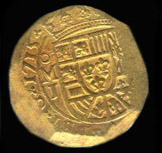 |
|
|
|
|
||
|
Colombian gold cobs
New World Portrait Gold
Pillar and Bust reales (
Latest News "Essential Books" Click here
©2007 Goldcobs.com All Rights Reserved. |
Mexico. Reign of Charles I (1516-56). An original Cortez-era "Tejuelo" or small Gold Ingot , which circulated as the equivalent of a 4 escudos coin. A very rare example of the "necessity" gold coinage mentioned in the chronicles of Bernal Diaz and Gomara, but previously not known, found on the GOLDEN FLEECE WRECK (1550)
One of the enduring mysteries of Mexican Colonial numismatics has been how New Spain apparently made do without a gold coinage until 1679. The Viceroyalty of New Spain had been a rich and commercially successful Spanish colony for nearly 150 years before Charles II finally authorized a standard gold coinage. But from as early as 1525 transactions in gold and silver are attested on a daily basis. How did this occur without some reliable form of gold currency circulating in Mexico? Spanish gold coins were very rare in the New World. Small pieces of gold cut from unassayed bars ("tepuzque") were very hard to value--what was their true gold content? A standardized and reliable form of gold was needed to make transactions in gold practical. How was this accomplished? Documents of the period are very clear: Cortes and his successors ordered that "tejuelos" or specially marked small ingots circulate in standard units of one, two and four tomines, later escudos. Until very recently nothing confirmed the documentary accounts. No "tejuelos" were thought to have survived from the era of Cortes and Mendoza!
The key documents are summarized in Lucas Alaman's scholarly 1844 history. In Volume I "The Conquest of Mexico and its Consequences" Alaman describes an April 26, 1526 order by Cortes' council that to facilitate commerce people with unmarked tepuzque gold must bring it to Cortes' foundry where it would be reduced to properly assayed and marked tejeulos valued at one, two, and four pesos. Each piece of gold with its ley ("fineness") clearly displayed " could then circulate and be used to buy and sell." So from early 1526, tejeulos struck in Cortes' foundry were authorized and began to circulate in New Spain.
The
second key figure
in understanding the early numismatic history of New Spain is
Antonio de Mendoza, the first viceroy. One of Mendoza's first
priority when he arrived in 1535 was to get a substantial
Mexican silver coinage launched. Commerce was still impaired because
an insufficient supply gold & silver managed to circulated in New Spain. Mexico City
immediately began to coin a substantial supply of silver, but no
gold coinage was
authorized. Unlike a later Viceroy at Lima,
Mendoza wisely did not attempt to do issue an
illegal gold coinage. Transactions in gold had become less difficult
because of the tejeulos issuing from Cortes' foundry.
Forbidden an official gold coinage, Mendoza's solution was to adopt
Cortes' tejeulos system and transfer it to the new official Casa de
Moneda.
Beginning in 1538 Mendoza authorized the mint to issue
tejeulos with clearly visible assays and their total gold
content carefully
adjusted to match the value of the new Spanish gold escudoss. Since these fractions did not bear a
denomination or the king's name, there was no illegal gold coinage,
but because of their standardized gold content they were happily accepted as the equivalent of Spanish
gold coins.
Our GOLDEN FLEECE ingot, pictured above, has a net weight of 14.32 gm and, as required, very prominently displays its 19.5 (to 19.75K) fineness. This weight and fineness represent nearly 11.9 gms of pure gold, a value well within tolerance weight for a Charles I four escudos, hence a perfectly acceptable commercial equivalent for the unavailable Spanish 4 escudos coin. Notice that the bar has been cut and adjusted at least FIVE times to achieve its weight. Like the many-faceted Mexican gold cobs that succeed it, this is a sure sign of a gold issue being carefully adjusted to the official gold standard.
By all accounts Cortes' and then Mendoza's necessity tejeulos coinage was an immediate and popular success. The Mexico City mint continued to issue escudos-equivalent tejeulos into the reign of Charles II (1666-1700). Despite the popularity and widespread use of these ingots, virtually none survive today, almost all no doubt remelted and re-issued in coin form in the 1700's. Escudos-equivalent ingots are especially rare from the era of Cortes and Mendoza. Before ten of these pieces were recovered from the GOLDEN FLEECE WRECK, whose coinage firmly dates it to 1549-50, ALL pre-1550 Mexican gold ingots were impounded in permanent public collections. Because of their historic importance, most of the GOLDEN FLEECE pieces have also disappeared from the marketplace, absorbed into permanent museum collections.
A February 2004 certificate from Dan Sedwick attests to the provenience of this gold ingot and seconds our remarks on the rarity of all surviving Charles I (1516-56) Mexican gold issues. This gold ingot shows virtually no traces of circulation and has attractive mint state luster. Almost certainty it was struck within a few years of its loss on the GOLDEN FLEECE. This piece sold is Sedwick's Treasure Auction #3 as lot 51, where it realized
Sold 480-595-1293.
|
|




